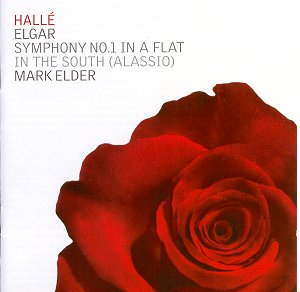Mark Elder is making
something of a name for himself as an
Elgarian, and is in the best of possible
places to do so considering that his
predecessors in his post in Manchester
include Richter, Harty and Barbirolli.
On the other hand that roll call could
make it a hard act to follow. The full
orchestra is listed at the back of the
booklet, and one wonders how many of
them were playing in Barbirolli’s day
thirty odd years ago, for the three
conductors listed above formed a fairly
continuous line to pass on the tradition,
while Elgar himself was a frequent guest
and friend to all three men. That does
not happen these days. Now we have moved
on, the Free Trade has given way to
the Bridgewater Hall. Michael Kennedy
has given the Elder era his blessing
and quite rightly so, the first movement
of the symphony, right from its stately
outset is full of Elgarian ebb and flow
in terms of its rubato, and the balance
of tempi is generally finely judged.
The scherzo fizzes with excitement,
tautly controlled in its dynamic range
and colourfully judged in highlighting
instrumental solos of the moment, although
Lyn Fletcher’s sweet tone as leader
could have been given more prominence.
The link to the Adagio is particularly
effective in its tension, the interpretation
never self-indulgent. Elder’s background
in opera is at its dramatic best in
the introduction to the finale, where
the opening bass-clarinet and bassoon
transport the listener into the realms
of Nibelheim. I have never heard the
combined first and second trombones
sound so effective (just a hair’s breadth
on the right side of vulgarity) at the
second half of the bar at fig.110. The
back-desk string players clearly enjoy
their fifteen bars of fame (they even
get another chance to shine later),
and then the Allegro itself gets underway
at what seems like an overly-hurried
tempo, but actually turns out to be
a shade under the composer’s marking
of minim/84. The second thematic idea
at figure 114 and again at figure 137
correctly ignores the piano dynamic
(Elgar told Richter on 3 October 1909
that it should be forte), the
Hallé brass blaze away as the
movement develops, and the woodwind
triplets at figure 127 are prominent
where over-exuberant violas and cellos
often smother them. Figure 130 threatens
overt sentimentality (it’s a hard moment
to resist and one never wants it to
be over in my experience of conducting
this symphony), but the outburst at
the climactic top B flat half a dozen
bars before figure 134 is effective
only because of a finely controlled
crescendo, held back until the last
possible moment. I regret the absence
of the Barbirollian hiatus across the
barline four and three bars before figure
143, but the portamento linking
G to D in the first violins at the second
and third bars of figure 144 is a stylish
touch, while the brass in this passage
are superb. Elder does not hang around
at the stringendo, more like
a subito piu mosso, its excitement
topped by a final crescendo to the last
chord, which will satisfy.
This generous supply of Elgar continues with
an equally exciting account of In the South (Alassio),
the Hallé at its best, the glorious horns enjoying their
moments of Richard Strauss. This is hardly surprising, as Elder’s
forays into that composer’s operas were always highly rewarding
experiences at English National Opera during his heyday there
as Music Director in the 1980s. His interpretation emphatically
underscores the mutual admiration between Elgar and Strauss, with
lush string textures followed in stark contrast by the edgy brittleness
of the ‘conflict of armies’ section between figures 20-26. Timothy
Pooley’s excellent viola solo has delicate poignancy, inspiring
Laurence Rogers (principal horn) to a couple of lyrically shaped
responses. Then it’s back to more Strauss (those single allargando
bars of four quavers straight out of Rosenkavalier), though
the Elgarian fingerprints are never far away, such as the occasional
connecting portamento in the strings. From figure 53 more
excitement is generated by ever-increasing speeds and meticulously
observed dynamic changes (Elgar and his masterly use of sudden
changes to piano), but as is so often the case with Elgar,
it’s the horns who lead a hero’s life, or in this instance a Heldenleben.
In July 1904, three months after In the South
was given its first performance, Elgar set some verses by Shelley
to the canto popolare and called it ‘In the Moonlight’.
With the viola solo fresh in the ear it makes a fitting conclusion
to this disc, and Christine Rice sings it with both feeling and
warmth of tone.
Christopher Fifield
